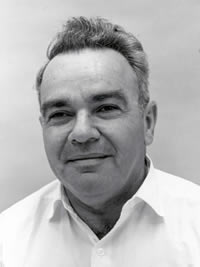Martin Kamen (1913-2002) was a Canadian-American physicist.
Kamen was seemingly destined for a landmark career in physics when he arrived at the Radiological Laboratory at the University of California, Berkeley in 1936. He was part of the group that discovered the synthesis of the carbon-14 isotope in 1940 and soon became a valuable member of the wartime Rad Lab team.
During the war he also spent time at the Oak Ridge project site. It was here that his promising career began to unravel. After noticing that some of the radioactive sodium he was preparing for an experiment seemed to be contaminated, Kamen deduced that the material must have been irradiated by a nuclear reactor located elsewhere in the facility. Given that he did not have the clearance to know about such a reactor, Kamen soon became the subject of surveillance by counter-intelligence officials after he reported his concerns to his superiors.
Soon after, Kamen returned to Berkeley. Trouble still seemed to follow him. He met two Russians at a party who shared his interest in classical music. One of them asked for information about experimental radiation treatment to help a colleague with leukemia. They coordinated dinner with Kamen to discuss their options further. Unbeknownst to Kamen, the two men were undercover agents of the KGB who were stationed at the Russian consulate in San Francisco.
Kamen was also unaware that he was being surveilled during this dinner meeting with the KGB agents, Grigory Kheifets and Grigory Kasparov. He would lose his position at Berkeley within months of the encounter, in an ironic twist of fate for one of the more politically moderate scientists to work at Berkeley during the war years.
After being fired by the Rad Lab, Kamen found it difficult to find work. His problems were exacerbated in 1948 when he was summoned to appear before the House Un-American Activities Committee (HUAC.) Further damaging his reputation was a 1951 article in the Chicago Tribune that named him as a suspected Soviet spy. Kamen was crushed by the persecution he faced, and unsuccessfully attempted suicide soon after the article was published.
In 1955, he sued the Tribune for libel and won, the first step towards restoring his reputation. As anti-communist fervor began to subside, Kamen was able to find opportunities to work again. He was able to take teaching positions at Brandeis University and the University of California, San Diego before winning the 1995 Enrico Fermi award for lifetime scientific achievement. The award was given by the U.S. Department of Energy, which runs the same Radiological Lab at Berkeley that had summarily fired Kamen 50 years prior.





